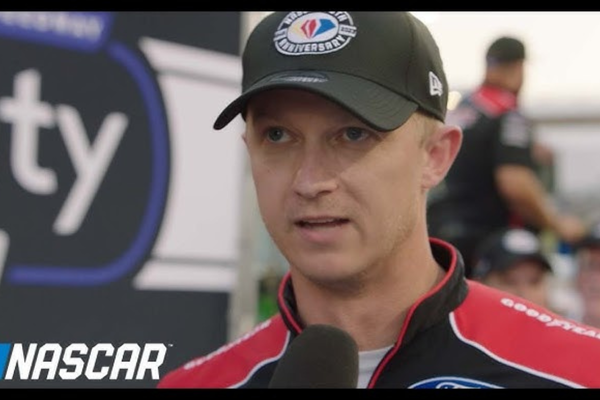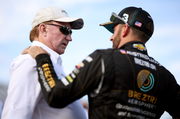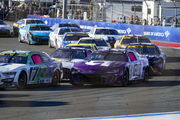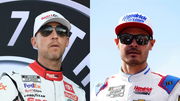

Why do NASCAR’s sharpest crew chiefs often come from engineering classrooms, not garages? Ryan Blaney’s crew chief, Jonathan Hassler, was studying race theory and thermal dynamics in a Purdue lecture hall long before Blaney stormed to a Cup Series victory in 2023. Chris Gabehart, who would subsequently lead Denny Hamlin‘s postseason runs, was seated a few seats away. It was more than simply a classroom; it served as a testing ground for two ideas that would shape contemporary NASCAR strategy.
Hassler chose a different route, but Gabehart found his fast track with Hamlin and Joe Gibbs Racing. His journey took him through data analytics rooms, simulation labs, and silent years of preparation within Team Penske’s technical division. He earned a star driver by contributing to its creation rather than being given one.
As the leader of Blaney’s crew, Hassler is changing the way Penske races rather than merely giving orders. Furthermore, the rivalry between their drivers is just one aspect of the situation, as Gabehart remains on the opposite side of the pit wall. There is a deeper story behind the on-track battles: two engineers who were once classmates are now influencing NASCAR’s future from opposite pit boxes.
ADVERTISEMENT
Article continues below this ad
We follow Jonathan Hassler’s journey in this profile, from Purdue student to Ryan Blaney‘s brain trust. We’ll look at how he won his spot on one of NASCAR’s most illustrious teams, how his shared history with Chris Gabehart created a respectful rivalry, and how his strategy-first approach may alter what it means to be a modern crew chief.
Who is Jonathan Hassler?
American NASCAR crew chief Jonathan Hassler is currently in charge of Ryan Blaney’s No. 12 Ford Mustang Dark Horse for Team Penske. Hassler was born in Greencastle, Indiana, and started racing go-karts and micro sprint cars when he was eight years old. He was adamant about pursuing a career in motorsports by the age of thirteen. In 2007, he received his Mechanical Engineering degree from Purdue University. Hassler co-founded Volunteer Motorsports, a student organization that supported local race teams while he was a student at Purdue, including ones driven by his classmate Chris Gabehart, who is currently Denny Hamlin’s crew chief.
Hassler joined Team Penske as an engineer in their Xfinity Series program following an internship with MB2 Motorsports/Ginn Racing. Before advancing to the Cup Series, he worked there for five years, helping drivers like Brad Keselowski, Joey Logano, and Kurt Busch. Hassler took over as crew chief for Wood Brothers Racing’s No. 21 vehicle in 2021, which was driven by Matt DiBenedetto. He rejoined Team Penske the next year to take over as Ryan Blaney’s crew chief. The two accomplished a great deal under his direction, including taking home the 2023 NASCAR Cup Series Championship.
On race day, Hassler, who is renowned for his analytical style, combines his engineering knowledge with strategic judgment. His transformation from a young racer in Indiana to a crew chief who has won a championship highlights his commitment to and influence on the sport.
Trending
What’s your perspective on:
Can Jonathan Hassler's engineering genius turn Ryan Blaney's 2025 slump into another championship triumph?
Have an interesting take?
How did Jonathan Hassler come to wear a crew chief’s hat at Team Penske?
Jonathan Hassler’s racing mentality was already adjusting laps long before he held the headset on NASCAR’s largest stage, but it was at Purdue University engineering labs under fluorescent lights rather than pit walls. Most teenage racing enthusiasts consider driving to be the pinnacle of their dreams. That was only the beginning for Hassler.
Hassler, who grew up in Greencastle, Indiana, was the type of youngster who was interested in learning why some vehicles were faster than others, in addition to winning races. He was already operating a go-kart at the age of eight. He was operating small sprint cars by the age of eleven. However, Hassler shifted from the driver’s seat to the drawing table as the competition grew fiercer and expenditures increased. He intended to develop racing from the ground up, not merely compete.
This way of evaluating things led him to Purdue University’s Mechanical Engineering program, where his practical intuition and academic accuracy started to meld. He met another future NASCAR crew chief there, Chris Gabehart. They were co-founders of Volunteer Motorsports, a student-run organization that provided support to local racing teams. Gabehart was the driver. Hassler ran the figures, wrenched, and evaluated. Even without the title, Hassler was functioning as a crew chief by the time he graduated in 2007.
An apprenticeship with MB2 Motorsports, which subsequently changed its name to Ginn Racing, provided him with a reprieve. After that, in 2008, he joined Team Penske and began working in their Xfinity Series program. It wasn’t glitzy. Most fans couldn’t even see it. But as a race engineer for Kurt Busch, Brad Keselowski, and Joey Logano, Hassler subtly established himself as one of the most intelligent people on pit road for more than ten years.
The year 2021 marked a sea change. Hassler replaced Matt DiBenedetto as crew chief of Penske’s satellite team, Wood Brothers Racing. Calling the shots, implementing the changes, and taking responsibility for the outcomes was his first real leadership challenge. People observed inside the garage, but the victory column remained empty. He was. methodical and reliable.
Team Penske’s long-term faith in Hassler’s system-first, ego-free approach was demonstrated in 2022 when they elevated him to crew chief for Ryan Blaney. Success came in spurts for a large portion of that first year. As the 2023 season got underway, the couple was under increasing strain and being questioned by detractors. Hassler, however, did not recoil. He continued to review data, improve setups, and quietly support Blaney. Whispers became reality when Blaney and Hassler won the 2023 NASCAR Cup Series trophy after a championship run propelled by playoff poise, strategic pit stops, and a driver- crew chief bond that developed at the ideal moment.
Hassler had been a crew chief all his life. The world simply took a long time to catch up.
How has Jonathan Hassler propelled Ryan Blaney to success?
There were no significant changes, no major announcements, and no spectacular confrontations when Jonathan Hassler succeeded Ryan Blaney as crew chief prior to the 2022 season. Rather, there was a silent change. a gradual burn. And a title at the end. Blaney had all the makings of a superstar for years. He was popular, polished, and quick. His career, however, had fallen into a discouraging pattern: near, but not near enough. He would push for the playoffs after winning a race or two, but he would lose steam as the pressure mounted. Something was missing, yet the tools were there.
Blaney required structure—a strategist who knew how to package speed, shape momentum, and transform unreliable speed into dependable outcomes. Enter Jonathan Hassler, a Greencastle, Indiana, engineer with a problem-solving mindset and a temperament that never faltered in the face of criticism. In 2022, their first year together was a learning exercise. Hassler observed Blaney rather than attempting to reinvent him. In what areas did the automobile need to improve in late runs? Without compromising track position, how could they modify their pit strategy? When ought they to retain, and when ought they to gamble?
Hassler created a feedback loop that was close, quick to react, and cooperative race after race. Blaney became more forceful in response. The erratic restarts became methodical. The annoyance subsided. What about the speed? It was always there. The No. 12 squad was not only ready for the 2023 playoffs, but they were also a threat. Hassler and Blaney excelled during a time when favorites recoiled and veterans crumbled. They demonstrated surgical focus at Phoenix, ran with accuracy at Homestead, and performed under duress at Martinsville.
It wasn’t flashy. It wasn’t loud. It was a blueprint working at peak efficiency. “I trust him with everything. Hass just has a way of staying calm, no matter what. That trickles down to everybody.” Blaney said after clinching his first NASCAR Cup Series championship.
When it counted most, Hassler provided Blaney with exactly what he needed, from tire strategy to chassis configuration. And more significantly, he believed him. Not the blind kind, but the one based on mutual respect, data, and repetition. Jonathan Hassler demonstrated that measured patience, consistent communication, and a keen engineering mind could still result in victories in a sport that frequently honors the brazen and the audacious.
ADVERTISEMENT
Article continues below this ad
Can Jonathan Hassler save Ryan Blaney’s 2025 slump and make him a 2-time Cup champ?
Even though the champagne from their 2023 title celebration hasn’t gone bad yet, Ryan Blaney and Jonathan Hassler are already engaged in an entirely different battle. The defending champions have had a rough 2025 season. The No. 12 vehicle has subtly slipped out of the weekly spotlight, speed has been erratic, and strategy decisions have failed. Regression like that could make some teams fear. However, panic is never the plan when Jonathan Hassler is on the box. This downturn? It’s a challenge, not a crisis. If history is any indication, Hassler doesn’t encounter only difficulties. He inverts their design.
“We’re not where we want to be right now. But I believe in the process. I believe in what we’re building,” Blaney admitted after a string of mid-pack finishes in early 2025. The procedure, the systematic reevaluation that characterizes Hassler’s methodology, is the reason this pair isn’t being dismissed. The 2025 title run might depend on something more challenging: rebuilding on the fly, whereas the 2023 run was driven by momentum and almost faultless execution.
“I thought our car was really good last week until I wrecked all of us on the backstretch, so just hope to keep that same pace, but I feel good with where our program is at right now. Just a matter of trying to get some stuff to go our way,” said Ryan Blaney ahead of the NASCAR Cup Series race at Homestead-Miami Speedway.
ADVERTISEMENT
Article continues below this ad
Hassler thrives in the gray region, where development is gradual and answers aren’t immediately apparent. It takes time to reinvent the automobile. The goal is to eliminate inefficiencies, analyze racing data, and make five decisions per weekend that culminate in a single breakthrough. Above all, he is familiar with his driver. Blaney changed from a streaking leader to a calculated championship closer with Hassler’s assistance. His consistency was unleashed. Now that the No. 12 team is trying to gain momentum, Hassler will have to unlock something equally important: belief.
Early on, the path to a second title might not be paved with trophies, but the foundation is in place. The faith. The dialogue. The silent urgency. Nobody should be shocked if the 2025 downturn serves as the prelude to another late-season surge if everything comes together again. Because even a poor season may turn into a blueprint for a championship when Jonathan Hassler is in charge of the plan.
ADVERTISEMENT
ADVERTISEMENT
ADVERTISEMENT
ADVERTISEMENT







Can Jonathan Hassler's engineering genius turn Ryan Blaney's 2025 slump into another championship triumph?